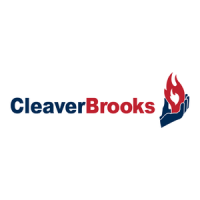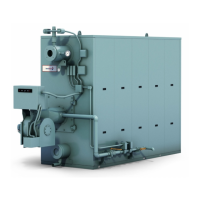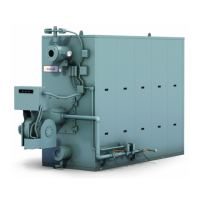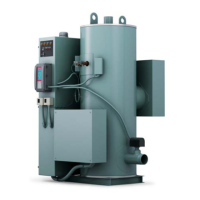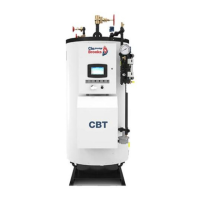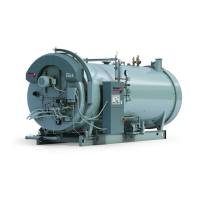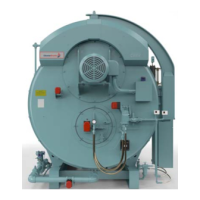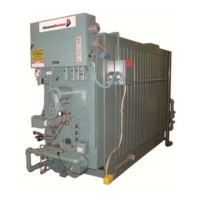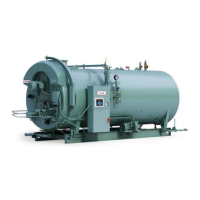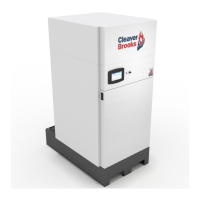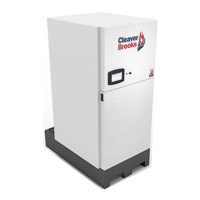Profire V Burner Chapter 2
750-177 2-7
GAS PIPING
Gas service and house piping must supply the quantity of gas
demanded by the unit at the pressure required at the burner
gas train inlet.
All piping must be in strict accordance with applicable codes,
ordinances and regulations of the supplying utility. In the
absence of other codes, piping should be in accordance with
the following standards: “National fuel Gas Code” NFPA No.
54, ANSI No. Z223-1.
Gas train components upstream of the butterfly valve are
shipped loose. These components should be mounted by the
installer as close to the butterfly valve as practical.
Normally, the control train is ordered to suit a particular code
or insurance regulation - such as Underwriters Laboratories/
Canadian Underwriters Laboratories (UL/cUL), Factory
Mutual, or Industrial Risk Insurance.
Arrange gas piping at the burner so that the burner is
accessible for servicing without disassembly.
The pilot gas train is supplied with the burner, and is factory
installed. The gas pilot supply line must be connected
upstream of the main gas regulator. If a reducing bushing is
required between the house piping and the burner piping, it
should be close to the burner shutoff valve.
The gas piping must be internally clean and free of foreign
material. Before using in service, a leak test must be
performed.
FUEL OIL PIPING
PRESSURE ATOMIZATION OIL PIPING
The VL and VLG model burners use pressure atomization.
Fuel oil is provided by a burner mounted fuel unit directly
coupled to the blower motor via a flexible coupling on Size 1
& 2 burners, Remote Pump on Size 3 & 4 burners. The
suction and return line sizes (two-pipe system) are based on
the suction rate of the fuel unit and not the burner firing rate.
Pipe size must be selected sot that suction vacuum is within
suitable limits.
TWO PIPE - SINGLE BURNER OPERATION
A two-pipe system is essential. The suction and return
between the storage tank or supply source and the burner
must be sized to supply the required quantity of oil circulated,
including excess oil returned to the storage tank.
SUCTION LINE SIZING
The Suction load is determined by:
1. The vertical lift from the oil level in the tank to the
pump.
2. Pressure drop through valves, fittings, strainers, etc.
3. The friction loss due to oil flow. This loss varies with:
a. Quantity of oil pumped (gph).
b. Length of suction line (feet).
c. Diameter of the suction line.
d. Number of fittings.
Although the gear type pumps used on the V series burners
are capable of developing higher suction, it is not desirable to
operate above 15 inches of mercury vacuum. If the vacuum is
greater, flow may be erratic.
Refer to the manufacturer’s table for line sizing.
1. Check suction capacity.
2. Measure total pipe length (horizontal and vertical).
3. Read up from line “total feet of copper tube” to the
intersection line of the specific “suction capacity” in
gph.
4. Read left to column “inches of vacuum at fuel unit.”
This is vacuum required to draw oil through pipe listed
at given length.
5. Add 1” of vacuum for every foot of lift.
6. Total inches of vacuum (frictional tube loss plus lift).
7. If total exceeds 15”, check next larger pipe size.
RETURN LINE SIZING
Generally, the return line should be sized the same as the
suction line.
TWO PIPE - MULTIPLE BURNER SYSTEM
Several options exist for a multiple burner installation.
The circulating pump is sized for the total suction capacity of
all burners. Note that a special pressure regulating valve is
required if the fuel unit inlet pressure is above 3 psi.
Depending on configurations:
• separate suction lines for each burner with a common
return line
• multiple burners with oil supplied by a transfer pump
• a pump supplies oil to the day tank
• flooded loop system - the circulating pump is sized
according to the maximum burner firing rate for all
burners plus a 30% service factor
Notice: CB Profire recommends that all oil fir-
ing burners be equipped with an oil strainer (if
not included with the burner) to prevent parti-
cles from clogging the nozzle. It is essential to
follow the strainer manufacturer’s maintenance
schedule to ensure proper filtration.
